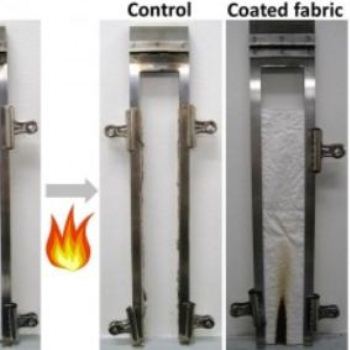Sep 1 2011
The technology in “fire paint” used to protect steel beams in buildings and other structures has found a new life as a first-of-its-kind flame retardant for children’s cotton sleepwear, terrycloth bathrobes and other apparel, according to a report presented here today at the 242nd National Meeting & Exposition of the American Chemical Society (ACS).
“People are concerned about the potential toxicity of flame retardants that are currently used on a variety of products, especially children’s pyjamas and the foam in children’s car seats,” said Jaime C. Grunlan, Ph.D., who led the research. “The water-based ingredients in this new coating are much less toxic to humans than the so-called ‘halogenated’ or ‘brominated’ flame retardants used in the past, and they are more environmentally friendly.”
 Fire completely destroys untreated cotton fabric until nothing remains (control), but only burns a small spot on cotton treated with a new flame-retardant nanocoating (coated fabric).
Fire completely destroys untreated cotton fabric until nothing remains (control), but only burns a small spot on cotton treated with a new flame-retardant nanocoating (coated fabric).
Grunlan explained that flame retardants are used on cotton, the most popular fabric in the world, because it can catch fire easily and burns rapidly with a hot flame. Flame retardants make it more difficult for fabrics to ignite, make them burn slower and make fabrics self-extinguish when the flame is removed. That margin of safety is especially important for clothing fires, which can cause severe and disfiguring injuries. Flame retardants allow time to remove the clothing or put out the flames.
In responding to the need for more environmentally friendly flame retardants, Grunlan’s team turned to a technology termed “intumescence,” long used to fireproof exposed interior steel beams in buildings. At the first lick of a flame, an intumescent coating swells up and expands like beer foam, forming tiny bubbles in a protective barrier that insulates and shields the material below. The researchers are at Texas A&M University in College Station.
“This work is the first demonstration of a polymer-based ‘nano intumescent’,” said Grunlan. “We believe it has great potential for use as flame retardants on clothing and other materials in order to avoid some of the disadvantages of existing products.”
The material is “nano,” or ultra-small, built up from layers of alternating positively and negatively charged polymers so thin that almost 50,000 would fit across the width of a human hair. Size has an advantage, Grunlan explained. Because these layers are so thin, the polymer liquid seeps deep into cotton fabric and onto each individual cotton fiber. Existing flame retardants, in contrast, simply settle on fiber bundles like armor and slow the spread of flames, but the fabric still burns and turns black. When the new nano coating is exposed to a flame, it expands slightly and stops the fire from igniting and burning the fabric — which remains white, except for the small area where the cotton directly touches the flame.
Grunlan noted that the new flame retardant addresses public concerns about the potential toxicity of flame retardants now used on a variety of products, especially children’s pajamas and the foam inside children’s car seats and toys, and pointed out that the water-based polymers used in the nanocoating are much less toxic to humans than other flame retardants used today.
Would clothing coated with the nano intumescent be stiff and dull? “The look and texture of the fabric would depend on the thickness of the coating and also on the specific polymer we use,” Grunlan pointed out. The nanocoating is deposited in alternate layers of positively and negatively charged polymers; swapping one of those polymers out for a different one in the recipe could offer similar anti-flammable protection while making the fabric softer.
Grunlan’s team is in the process of optimizing the flame retardant so that it remains on cotton fabrics despite frequent laundering. “We haven’t done anything yet to protect the coating, but we believe that with further research, we could make this an almost permanent addition to the fabric,” he explained.
They also plan to test the coating on other materials, such as polyester and foam, possibly with commercial partners.